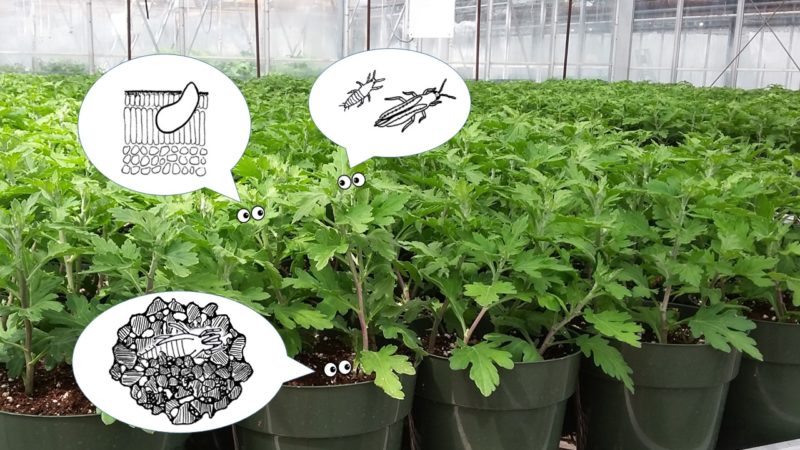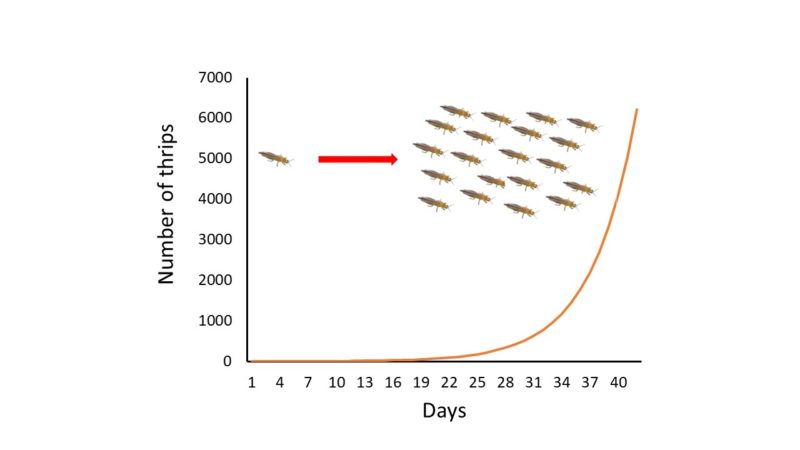The Perfect Pest
If I had to design the perfect pest, it would end up close to being thrips. Although I might make it a little cuter so that people feel guilty about wanting to get rid of it.
As they are, thrips are well-adapted to survive, thrive and cause many problems. This article will focus on Western flower thrips, one of the most problematic thrips species in the world in greenhouse and field crops.
PESKY PERFECTION
To feed, thrips adults and larvae puncture plant cells with their mouthparts, secrete saliva to digest the cell contents and then suck it all up. This results in clusters of damaged cells with a typical silvery appearance surrounded by black spots of feces and distorted growth of leaves, fruit or flowers. Thrips feeding can transmit as well destructive plant viruses including tomato spotted wilt virus (TSWV) and impatiens necrotic spot virus (INSV).
Thrips also like to feed on pollen and other nutrient-rich food sources such as spider mite eggs to supplement their diet.

Several reasons exist why thrips are so difficult to control. Firstly, thrips are thigmotactic insects, meaning they like to squeeze into cracks or crevices driven by their preference for close quarters (Figure 1).
This behavior makes them difficult to control, as they can hide in large numbers of places where pesticides may not reach. In addition, thrips eggs are inserted in the leaf tissue and pupae hide in the substrate or other concealed spaces, which again protects them from direct sprays.
Second, unchecked thrips populations can increase very rapidly. A thrips female lays about seven eggs per day. Since she can live for more than a month, she easily produces more than 200 offspring in her life.
The young thrips also grow up very quickly and are ready to reproduce in nine to 13 days at temperatures around 77 to 86° F. This means that a population can go from one to 6,000 thrips in about 42 days (Figure 2).

Third, it seems like thrips can eat almost anything. Their host range spans over 500 plant species in 60 families. They are able to cope with a diversity of plant defenses by detoxifying plant defensive compounds. Unfortunately, this also enables them to contend with a range of insecticide classes. There are at least 175 documented cases of insecticide resistance in Western flower thrips from around the world, involving at least eight different mode of action groups.
Finally, genetically, thrips do not leave much up to chance, especially the males. Males only have one full set of chromosomes, so traits like pesticide resistance or adaptation to a new environment are under direct selection and only the successful genes make it to the next generation.
Female thrips have two sets of chromosomes, but have their own secret weapon: they do not have to mate to produce male progeny. In most cases, the female will live long enough to mate with her own offspring, so one female is enough to found a new population.
COMBATING THE WORLD TRAVELERS
Still, thrips could not have achieved their perfect pest status without us. Originally, Western flower thrips were native of western North America. It is likely that intensive insecticide use in the 1970s and 1980s resulted in a highly insecticide-resistant strain or multiple strains, which then spread throughout North America and to Europe, Asia, Africa and Australia.
On their own, thrips can disperse through flying short distances, and are carried by wind currents over longer distances. However, most of the spread of thrips worldwide was, and still is, facilitated by the global movement of plant material, such as fruits, cuttings, seedlings and potted plants.
So what do we do? We use what nature has already perfected: their own natural enemies. In addition, we breed plant defenses back into our crops and throw in a lot of human ingenuity. Because, we are smarter than a thrips, aren’t we?


 Video Library
Video Library 




















